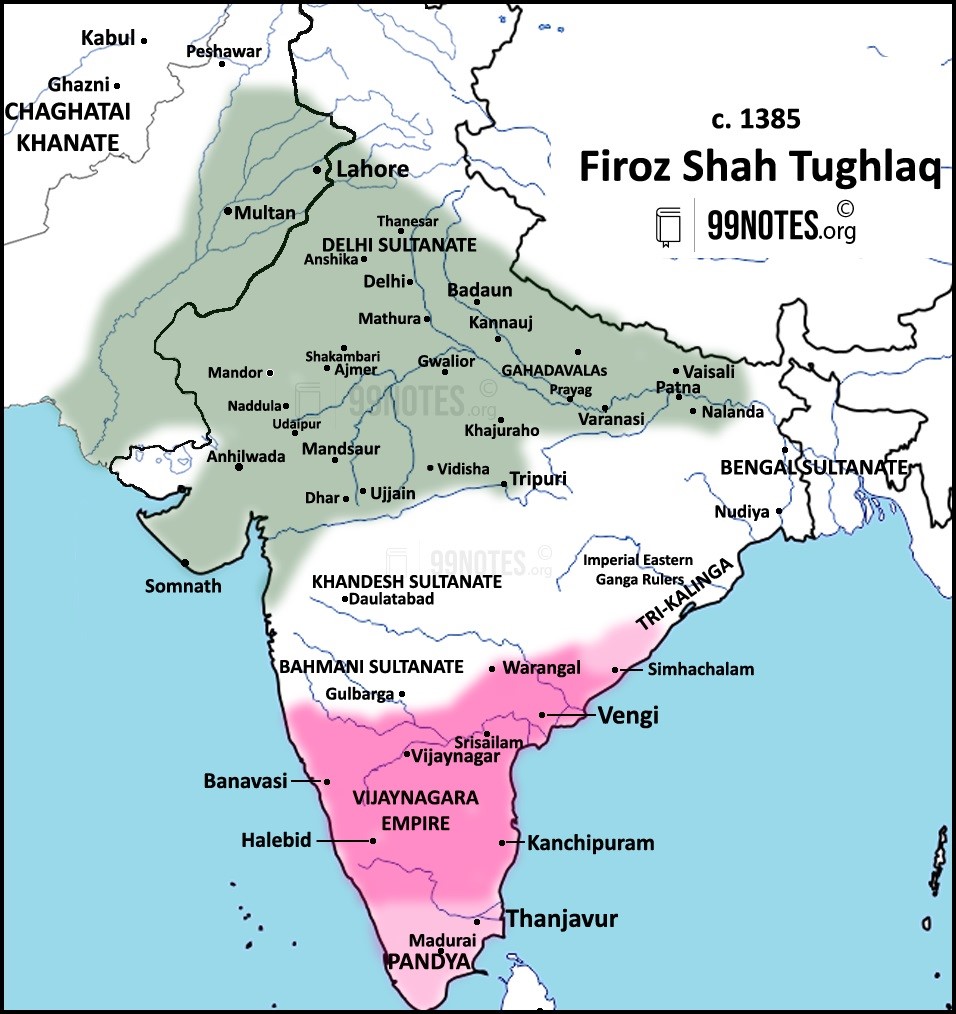Firoz Shah Tughlaq rule as discussed by Harsh
After flourishing for more than three decades, the Khilji empire came to an end as they were replaced by Tughlaqs in c. 1320 AD. Ghiyas-ud-din Tughlaq was the founder of Tughlaq dynasty but he ruled only for short-period of time of only five years. After that his son Muhammad-Bin-Tughlaq (MBT) ascended the throne of Delhi Sultanate in c. 1325 AD. After his death in c. 1351 AD, Firoz Shah Tughlaq, cousin of MBT, succeeded him.

His long reign of 37 years enjoyed a significant place in Turko-Afghan rule in India. He sat on throne when Sultan Muhammad Bin Tughlaq died suddenly after falling his horse at Thatta in c. 1351 AD. Because there was no male heir to Muhmmad Bin Tughlaq, the crown was offered to Firoz Shah Tughlaq. He was raised by MBT like his son and he was used to accompany MBT during wars and battles. But after ascending the throne, he faced number of challenges but he responded them smartly.
Also Read : Muhammad Bin Tughlaq – Estimate of His Personality
Muhammad Bin Tughlaq – Taxation and Agriculture Farm
Muhammad Bin Tughlaq – Khurasan and Qarachil Expeditions
Challenges Faced by Firoz Shah After Ascending the Throne
When Muhammad Bin Tughlaq died in c. 1351 AD., there was crisis everywhere. Entire Peninsular India declared independence and Madurai was the first to do so in c. 1335 AD. In c. 1336 AD, the Vijayanagara Empire was founded was Harihara and Bukka.
In c. 1347 AD, Bahmani Kingdom covering parts of Madhya Pradesh, Maharashtra, Gujarat, Andhra and Karnataka was founded by Alauddin Hasan Bahman Shah. Sindh was up in arms. At the time of his death, he was busy in suppressing that revolt of Sindh. Peoples of Delhi was living a resent life because of the transfer of capital. The peasants of Doab also become rebellious because of the taxation reforms in Doab region.

Taking advantage of death of MBT, the Governor of Bengal, Haji-Elias-Shah declared independence. Nobles, Ulemas and military personnel were unhappy because of the attitude and policies of MBT towards them.
Response of Sultan Firoz Shah Tughlaq
Although Firoz Shah ascended the throne but he was a weak administrator and weak military commander. He was a man of religious mindset and hence hardly contained the qualities of an efficient administrator. Therefore, he responded with a policy of appeasement. He tried to rule by keeping every section of population happy. He did not try to reconquer the territories that had declared independence before.
He organised two campaigns to reconquer Bengal in c. 1353 and c. 1359 but both were failures. A campaign was also launched to reconquer the Sindh region in c. 1361-62 but ended in miserable failure as Sultan himself hot lost in the desert of Sindh for six months. Prime minister Khan-e-Jahan Telangani had to sent his army to find Sultan. After these failures, he decided to accept status-quo on external fronts.
Firoz Shah Tughlaq made the system of Iqta hereditary to appease the nobles and other privileges took away by MBT also restored by him. To appease Ulemas, he made them an integral part of the politico-administration and started to took every decision after consulting with Ulemas. To appease military, he reversed the rate of Khum to 1/5th of war booty and 4/5th to distribute among soldiers.
A number of welfare measures undertook by him for Muslim subjects and peoples of Delhi. To appease peasantry, number of reform and measure were also taken in primary sector of economy.
Thus, these policy of appeasement and other welfare measure allowed him to rule for almost four decades. With this policy of appeasement, he hardly faced any challenge during his reign.

Pingback: Firoz Shah Tughlaq – Revenue, Agrarian and Welfare Measures